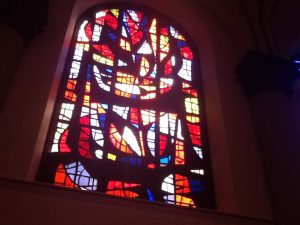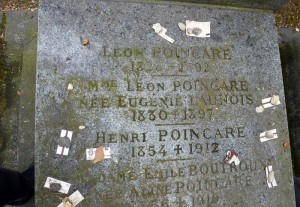A sticker on a shop wall in East Finchley, London, June 2016 (HT: JG).

Brussels life
Female composers
Several newspapers have recently carried reviews of a new book presented short biographies of 8 female composers (Beer 2016). It is certainly true that female composers have suffered from misogyny, and probably still do. But the situation is more subtle than it may appear at first. The discrimination may arise because composers such as Fanny Hensel (neé Mendelssohn) wrote mostly for small-scale, intimate forms, such as lieder and solo piano. Hensel wrote no operas or concertos or symphonies, as far as I know. Since the industrial revolution our society, one could argue, has favoured the grand and the grandiose, so anyone who writes only in small forms is ignored. This is true even of male composers: Hugo Wolf, who wrote art song, is unjustly overlooked, for instance. (This bias for the big and bombastic could also be a strongly male one.)
Against this argument that composers need to go large or be ignored, one could cite the case of nineteenth century French composer Louise Farrenc, who wrote symphonies and full-length chamber works (indeed, very good ones), yet still was ignored by the musical establishment. Despite her music being as good as Schumann’s or Mendelssohn’s, she still is ignored. Even Beer does not, apparently, profile her.
Hensel’s brother, Felix, was a symphonist and composer of overtures who audibly honed his technical craft writing a dozen string symphonies for the pick-up orchestra his mother assembled for the family’s weekly salon concerts each Sunday afternoon in Berlin. Very few women composers have had such an advantage, which perhaps explains something of Felix Mendelssohn’s comparative abilities. But Fanny Mendelssohn certainly had access to this resource. What explains her failure to write for it? Was it some pressure in the family, or just in herself? Did their parents, perhaps unconsciously and subtly, expect Felix to write pieces for the family salons, but not expect Fanny to do so? Was it a matter of social and class expectations of gender roles which the family had internalised? Or was Fanny simply lacking in confidence? She once wrote a song to secretly communicate her love for the man who later became her husband at a time when her parents refused to allow the pair to meet or write letters, so it seems she could disobey the spirit of any explicit family imposition, if not the letter.
Or are we looking in the wrong place entirely here? The Mendelssohns’ father and his brothers were bankers. Felix’s father took him to Paris as a teenager to meet Cherubini explicitly to assess whether the boy had a future as a composer. It is easy to imagine that his father wanted him to follow in the family bank, so perhaps Felix had to fight to get to be a composer. It was not, perhaps, that the family discouraged Fanny in particular from a career as a composer but that both children were thus discouraged, but only Felix resisted this pressure. To be honest, however, Felix’s published letters (in English) do not reveal any such discouragement from their parents, although these were bowdlerized.
Reference:
Anna Beer [2016]: Sounds and Sweet Airs: The Forgotten Women of Classical Music. Oneworld, London, UK.
Courage, honour, valour
For as long as I can remember, I have had to endure lectures from men in uniforms – policemen, soldiers, teachers, clerics – about courage and honour. I recall a particular egregious lecture from a cleric on the cowardice of men who had long hair. (For next millennium readers, this was part of a larger argument accusing anyone not supporting US and Australian involvement in the second Indo-Chinese war of cowardice. Of course, it required great courage for a 17-year-old conscript to openly confront such logically specious, and morally tendentious, nonsense.) The forces of conservatism always accuse those who confront them of cowardice, it seems.
The Hillsborough coronial verdict shows just what true courage and valour and honour are: It is fighting for justice against all odds, against the overwhelming sentiment of those in authority and of society in general, against friend and peer, as well as journalist and foe, against recalcitrant judges and lying policemen. But courage is also admitting when one has made a poor decision, and bravely facing the consequences of that decision. It is not too late for these men in uniform to finally reveal some courage and accept the consequences of their negligence, their lack of preparation, and their poor judgment.
Historic compromises
After the coup in Chile in 1973 which overthrew the democratically-elected administration of Salvador Allende (and which killed him and many others), the Eurocommunist left in Western Europe spoke of the need to have a grand “historic compromise” before entering Government: enjoining the centre and centre-right to support a coalition of national unity, so as to preclude, or at least inhibit, the right from undermining an elected government of the left. One of the ironies of history was that it was the left in government – the communist regimes of Eastern Europe – which were forced to forge such grand compromises, by conducting negotiations and sometimes forming coalitions (albeit, short-lived) with their non-communist opponents in Poland, Hungary, Czechoslovakia, Bulgaria, and even Zimbabwe.
Notes from Underground
For any fifth millennium readers, here are some incidents and observations from London’s Underground:
- Northern Line, Barnet Branch, heading into London, a hot summer’s day in July 2022, about 10am: A middle-aged man reads a pocket-sized book. Beside him, a woman he does not know with a child of about three years, looks over his shoulder to see what he is reading, and then starts to recite aloud a poem. It is the Shakespearean Sonnet about a summer’s day, #18. After that, she then recites Sonnet #130, about the futility of comparisons. They discuss the Sonnets. She says she is an English teacher. She has an American accent.
- Northern Line, East Finchley station, heading South, a weekend day in summer 2017, about 17.00: Two teenage boys, about 14 or so years old, ride skateboards down the footpath on the High Street to the Station, riding around pedestrians and bantering as they go. They enter the station and join the first train south, boisterously and loudly sitting across from each other and still engaging in banter. They are not hurting anyone, but some of the older passengers seem offended or scared. Into the same carriage a young woman with a baby in a pram also enters and she sits on a fold-down seat in the middle of the carriage, with the pram beside her. She forgets to lock the wheels of the pram. So, as the train starts off, the pram rolls backwards, towards the two boys. Immediately, both boys leap up to grab it from their seats on opposite sides of the aisle. As they return it to the woman, the look in her eyes is one of great relief.
- Northern Line, Bank branch, heading north, Saturday 2016-04-09, 21.35: A dozen drunk young women board the train at Old Street, all but one dressed as elderly women, with wigs, granny glasses, handbags, etc. One is dressed in pyjamas and a dressing gown – presumably she is the bride-to-be. Several carry large plastic penises. They are loud and boisterous, but good-natured. The gentleman sitting opposite, a dapper man in his 60s with a thin moustache, dressed in a suit and tie, with a flower in his lapel and a silk handkerchief in his top pocket, awakes from his slumber. It turns out that he too is drunk, and, in a loud Irish accent, he engages the women. Banter is exchanged, and there are smiles and laughter the length of the carriage. The women detrain at Kings Cross, the Irish gent following them. Was that his planned stop, one wonders? What does it say about our culture that a young person seeking to act trangressively dresses as a very elderly person?
- Northern line, London Bridge station, northbound platform, a Friday evening in February 2014, around 23.30: the platform is empty apart from a group of 8 men in suits and ties, in their early 20s, huddled in a close circle with arms around one another. They are taking turns to ingest something, each throwing his head back as he does.
- Northern line, Charing Cross branch, heading south, a station between Euston and Embankment, a cold winter’s morning in winter 2012-2013, all the seats in the carriage taken, but the aisle free: a passenger stands up to detrain as the train stops. Apparently his gloves had been sitting in his lap and these are thrown off in different directions as he stands up. He does not see this and moves to leave. Both gloves are caught superbly by other passengers seated opposite and on different sides of him, and one of these passengers shouts at him. He turns and both gloves are thrown back to him. He catches both and shouts his thanks. The scene looked choreographed and rehearsed, so perfect are the four arcs of the flying gloves and the catches.
Ends and Means
I have just read the memoir of Michael Hayden, USAF General and former head of both NSA and CIA. The book is interesting and mostly well-written. It appears, as much as such a memoir could be, honest and truthful.
The torture of detainees undertaken by CIA personnel took place before Hayden was Director, so he could absolve himself of it completely. But, as he did while Director and subsequently, he defends strongly and bravely his CIA staff, who acted under what they believed were legal orders and within what they believed to be constitutional limits. This defence is admirable.
How one could imagine that torture would be legal under a constitution which prohibits cruel or unusual punishments remains one of the great mysteries of our age. Hayden, however, also defends the torture itself. He does so on grounds of effectiveness, grounds which are demonstrably, and which have repeatedly been demonstrated to be, spurious. It is no good Hayden, or any other official paid by the public purse, saying “trust me, I know”. We live in a democracy, and we need, we citizens ourselves, to see the evidence. It has not ever been provided, at least not definitively and uncontestably.
Such a defence is essentially that the end justifies the means. As a Roman Catholic, Hayden should appreciate the counter-argument that rebuts this defence: that certain means may vitiate, or irredeemably taint, the ends. So, even if using torture were to be more effective than not using it, we still should not use it. We should not because torture is contrary to our values as a humane, civilized, society, respectful of human dignity, and because using it undermines any claims we may have to moral superiority over our terrorist enemy.
Like players cheating in sports, support for torture shows what sort of person you are, and what values you consider important. Hayden seems like an intelligent, thoughtful, and humane person, so it is a great pity that he, and others in the Bush 43 administration, came to view torture as acceptable. Not everyone in CIA thought so, which was, indeed, how we citizens came to learn about the secret detention camps and the torture in the first place.
Reference:
Michael V Hayden [2016]: Playing to the Edge: American Intelligence in the Age of Terror. New York: Penguin Press.
Paris life
Brussels life
Composition xi by Theo van Doesburg at Bozar.
Teleology Watch
I wonder about New Scientist magazine. A recent article on plant evolution is encased in a teleological argument:
“Plants have evolved forgetfulness to wipe out memory of stress”
An entity may do action A which has consequence X. But that is very different to saying that the entity did action A in order to achieve outcome X. The theory of evolution makes no assumptions of intentionality. Indeed, quite the reverse – the classical Darwinian theory assumes that outcomes of evolutionary processes (whether non-detrimental or not) are the result of changes (eg, mutations) that happen apparently by random chance. Only with epigenetics and modern Lamarckism is there perhaps a role for non-random changes.
Moreover, evolution is a theory at the species level and across time. It makes no sense to talk about evolution of an individual or of a single generation. Yet only individual plants and animals have any intentionality. Who or what is the entity that could have an intention for a species to evolve towards a certain goal? The entity would have to be both a cross-individual and a cross-generational collective. Ain’t such a thing, at least not in the material realm.


